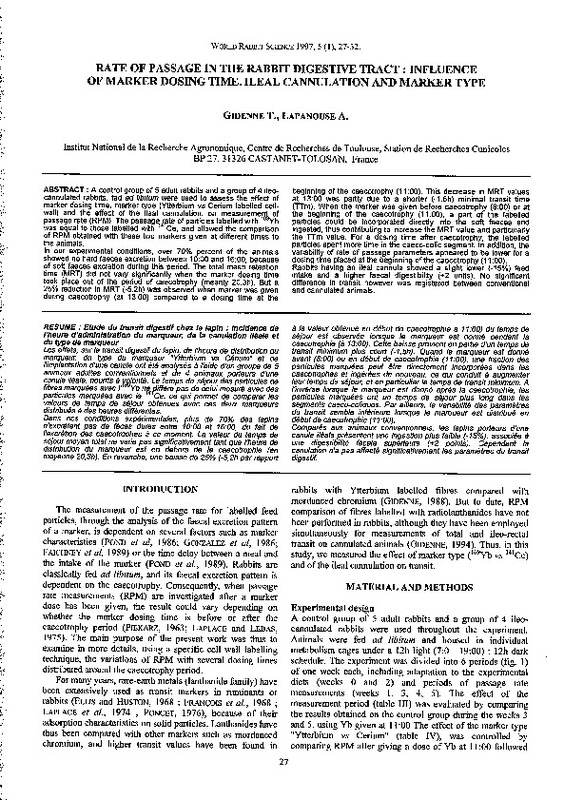JavaScript is disabled for your browser. Some features of this site may not work without it.
Buscar en RiuNet
Listar
Mi cuenta
Estadísticas
Ayuda RiuNet
Admin. UPV
RATE OF PASSAGE IN THE RABBIT DIGESTIVE TRACT : INFLUENCE OF MARKER DOSING TIME, ILEAL CANNULATION AND MARKER TYPE
Mostrar el registro sencillo del ítem
Ficheros en el ítem
| dc.contributor.author | GlDENNE, T.
|
|
| dc.contributor.author | LAPANOUSE, A.
|
|
| dc.date.accessioned | 2011-03-21T09:55:28Z | |
| dc.date.available | 2011-03-21T09:55:28Z | |
| dc.date.issued | 1997 | |
| dc.identifier.issn | 1257-5011 | |
| dc.identifier.uri | http://hdl.handle.net/10251/10444 | |
| dc.description.abstract | [EN] A control group of 5 adult rabbits and a group of 4 ileocannulated rabbits, fed ad libitum were used to assess the effect of marker dosing time, marker type (Ytterbium vs Cerium labelled cellwall) and the effect of the ileal cannulation, on measureme~~ of passage rate (RPM). The passag;¡.P,te of particles labelled with Yb was equal to those labelled with Ce, and allowed the comparison of RPM obtained with these two markers given at different times to the animals. In our experimental conditions, over 70% percent of the animals showed no hard faeces excretion between 10:00 and 16:00, because of soft faeces excretion during this period. The total mean retention time (MRT) did not vary significantly when the marker dosing time took place out of the period of caecotrophy (meanly 20.3h). But a 25% reduction in MRT (-5.2h) was observed when marker was given during caecotrophy (at 13:00) compared to a dosing time at the beginning of the caecotrophy (11 :00). This decrease in MRT values at 13:00 was partly due to a shorter (-1.5h) minimal transit time (Tim). When the marker was given befare caecotrophy (8:00) or at the beginning of the caecotrophy (11 :00), a part of the labelled particles could be incorporated directly into the soft faeces and ingested, thus contributing to increase the MRT value and particularly the Tim value. For a dosing time after caecotrophy, the labelled particles spent more time in the caeco-colic segment. In addition, the variability of rate of passage parameters appeared to be lower for a dosing time placed at the beginning of the caecotrophy (11 :00). Rabbits having an ileal cannula showed a slight lower (-15%) feed intake and a higher faecal digestibility (+2 units). No significant difference in transit however was registered between conventional and cannulated animals. | es_ES |
| dc.description.abstract | [FR] Les effets, sur le transit digestif du lapin, de f'heure de distribution du marqueur, du type du marqueur "Ytterbium vs Cérium" et de /'implantation d'une canu/e ont été analysés él f'aide d'un groupe de 5 animaux adultes conventionnels et de 4 animaux porteurs d'une canu/e iléale, nourris a Yf?ilonté. Le temps de séjour des particules de fibres marquées avec /' Yb n~ f!jffére pas de celui mesuré avec des particules marquées avec le 4 Ce, ce qui permet de comparer tes valeurs de temps de séjour obtenues avec ces deux marqueurs distribués a des heures différentes. Dans nos conditions expérimentales, plus de 70% des lapins n'excrétent pas de feces dures entre 10:00 et 16:00, du fait de f'excrétion des caecotrophes a ce moment. La valeur du temps de séjour moyen total ne varie pas significativement tant que f'heure de distribution du marqueur est en dehors de la caecotrophie (en moyenne 20,3h). En revancha, une baisse de 25% (-5,2h par rapport él /a valeur obtenue en début de caecotrophie él 11 :00) du temps de séjour est observée lorsque le marqueur est donné pendant la caecotrophie (él 13:00). Cette baisse provient en partie d'un temps de transit mínimum plus court (-1,5h). Quand le marqueur est donné avant (8:00) ou en début de caecotrophie (11:00), une fraction des partículas marquées peut etre directement incorporées dans les caecotrophes et ingérées de nouveau, ce qui conduit él augmentar /eur temps de séjour, et en particu/ier le temps de transit mínimum. A /'inversa lorsque le marqueur est donné aprés la caecotrophie, les partículas marquées ont un temps de séjour plus long dans les segments caeco-coliques. Par ailleurs, la variabilité des parametres du transit semble inférieure lorsque le marqueur est distribué en début de caecotrophie (11 :00). Comparés aux animaux conventionnels, les /apins porteurs d'une canu/e iléa/e présentent une ingestion plus faible (-15%), associée él une digestibilité fécale supérieure (+2 points). Cependant la canulation n'a pas affecté significativement les parametres du transit digestif. | |
| dc.language | Inglés | es_ES |
| dc.publisher | World Rabbit Science. ICTA. UPV | es_ES |
| dc.relation.ispartof | World Rabbit Science | |
| dc.rights | Reserva de todos los derechos | es_ES |
| dc.title | RATE OF PASSAGE IN THE RABBIT DIGESTIVE TRACT : INFLUENCE OF MARKER DOSING TIME, ILEAL CANNULATION AND MARKER TYPE | es_ES |
| dc.type | Artículo | es_ES |
| dc.date.updated | 2011-03-21T09:45:38Z | |
| dc.identifier.doi | 10.4995/wrs.1997.315 | es_ES |
| dc.rights.accessRights | Abierto | es_ES |
| dc.description.bibliographicCitation | Gldenne, T.; Lapanouse, A. (1997). RATE OF PASSAGE IN THE RABBIT DIGESTIVE TRACT : INFLUENCE OF MARKER DOSING TIME, ILEAL CANNULATION AND MARKER TYPE. World Rabbit Science. 05(1). https://doi.org/10.4995/wrs.1997.315 | es_ES |
| dc.description.accrualMethod | SWORD | es_ES |
| dc.relation.publisherversion | https://doi.org/10.4995/wrs.1997.315 | es_ES |
| dc.description.volume | 05 | |
| dc.description.issue | 1 | |
| dc.identifier.eissn | 1989-8886 | es_ES |








